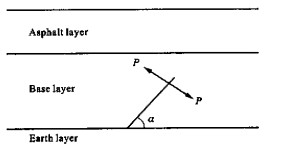Analysis on the stress intensity factor(SIF)for mixed-mode crack atbottom base layer with weight functions expressed with matrix
-
摘要: 由于基层材料的变异性、基层干缩(尤其是水泥基基层)、温度应力、土基压实不够、施工和养护不当,以及混合型荷载等都会在基层形成混合型裂缝,这些裂缝很容易形成反射裂缝,因而分析基层混合型裂缝应力强度因子就非常有必要。根据能量准则、叠加原理、贝蒂互换定理等推导出用矩阵权函数计算混合型应力强度因子的方法。并分析了待定权函数系数的求法,即结合有限元计算混合型裂缝应力强度因子方法求出待定的权函数系数,继而得到了矩阵型权函数。并利用有限元检验得到的权函数,两种不同方法在不同荷载作用下的计算结果吻合得很好,表明该方法可行。并编制了相应的程序来实现上述理论,对研究反射裂缝扩展和工程应用非常有益。Abstract: Due the variations of materials, shrinkage of base layer(especially the cementitious binder is used), temperature stresses, poorly compacted soil, poor constraction and poor maintenance and the mixed-mode loads subjected to the pavement, mixed-mode cracks are easy to occur at the bottom of the base layer of pavements, so it is necessary to analyze the stress intensity factors for the mixed-mode cracks at the bottom of base layer.The method to calculate the mixed-mode stress intensity factors is derived with the matrix weight functions according to the energy rule, superpostition theory and Betti's reciprocity theory.The method to get the constant coefficients of weight functions is also analyzed, which is based on the SIFs by finite element method.The weight functions are checked by the finite element method, and the agreement appears to be fairly good for the whole results by the two methods, which reveals the weight function method is very efficient.Thecorresponding programs arealso made, and it will be useful for analysis on the reflecting cracks in pavements and the engineering applications.
-
Key words:
- weight function /
- matrix /
- base layer /
- stress intensity factor(SIF) /
- finite element
-
表 1 有限元计算的混合型应力强度因子 (MPa·cm1/2 )
Table 1. Mixed-mode SIFs by finite element method

表 2 混合型权函数系数
Table 2. Coefficients of mixed┐mode weight function

表 3 有限元和权函数方法的应力强度因子计算结果 (MPa·cm1/2)
Table 3. SIF results by finite element method and weight function method

-
[1] BÜECKNER H F. A novel principle for the computation of stress intensity factors[J]. ZAMM, 1970, 50 (9): 529-546. [2] RICE J R. Some remarks on elastic crack-tip stress fields[J]. Int. J. Solids Structure, 1972, 8 (10): 751- 758. [3] LUORui, HUANG Xiao-ming, LU Yuan, ZHANG Wang. Research on the influence by base layer to the stress intensity factor of pavement with continual layers[J]. Journal of Southeast University, 2001, 31 (5): 61-64. [4] LUO Rui, HUANG Xiao-ming. Research on the method to calculate the stress intensity factor of asphalt pavement's edge crack[J]. Journal of Highway and Transportation Research and Development, 2002, 19(1): 12-15. [5] LUO Rui, HUANG Xiao-ming. Calculation on the stress intensity factor for the bottom crack of asphalt pavement's asphalt layer considering partial constraint by weight function[J]. Chinese Journal of Geotechnical Engineering, 2001, 23 (5): 610-614. [6] PETROSKI H J, ACHENBACH J D. Computation of the weight function from a stress intensity factor[J]. Engng. Frac. Mech., 1978, 10(2): 257-266. doi: 10.1016/0013-7944(78)90009-7 [7] WILLIAMS M L. Stress singularities resulting from various boundary conditions in angular corners of plates in extension[J]. J. Appl. Mech., 1952, 19 (4): 526-528. doi: 10.1115/1.4010553 [8] MANU C. Quadratic isoparametric elements as tran- sition elements[J]. Engng. Frac. Mech., 1986, 24 (4): 509-512. doi: 10.1016/0013-7944(86)90224-9 [9] CHONG Rhee H. Stress intensity factor evaluation from displacements along arbitrary crack tip radial lines for warped surface flaws[J]. Engng. Frac. Mech., 1989, 32(5): 723-732. doi: 10.1016/0013-7944(89)90168-9 [10] LESLIEBanks-sills, SHERMAN D. Comparison of methods for calculating stress intensity factors with quarter-point elements[J]. Int. J. Frac. 1986, 32 (2): 127-140. doi: 10.1007/BF00019788 [11] ZHANG S. FEM analysis on mixed-mode fracture of CSM-GRP[J]. Engng. Frac. Mech., 1986, 23 (3): 521-535. doi: 10.1016/0013-7944(86)90160-8 [12] CHONG Rhee H, MAMDOUH M Salama. Mixedmode stress intensity factor solutions of a warped surface flaw by three-dimensional finite element analysis[J]. Engng. Frac. Mech., 1987, 28 (2): 203- 209. doi: 10.1016/0013-7944(87)90214-1 -





 下载:
下载:





